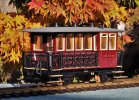David1226
Registered
On 20 March 2016 I attended G-Rail 2016 at Stafford Show Ground. On a layout named Trumper’s Halt I saw the below pictured 4-wheel coach that totally intrigued me and fired my imagination. It was a 4-wheel coach with a balcony running along part of one side. Unfortunately the owner was not present at the time so I was unable to find out anything about it. It has the appearance of being scratch built and of Indian or Asian origins. I have no idea if it was based on a prototype or was just a flight of the builders fancy.

It had always been my intention that all of the passenger stock on the Claptowte Railway would be 8-wheel bogie vehicles, albeit some of them being converted from a variety of 4-wheel vehicles mounted back to back on bogies. Over the years I collected the necessary donor vehicles and always collected to a plan, being disciplined, and, not allowing myself any impulse purchases. It was always intended that the coaches, although of different designs and origins, would conform to a corporate appearance and livery. As much as I wanted one, it was difficult to see how I could justify a vehicle such as the one above, in my line up. One day I had a moment of clarity, many private railway companies, whether full or narrow gauge, had special vehicles set aside for the exclusive transport of the railway’s owner and/or company directors. That was the answer, the Claptowte Railway needed a Director’s coach.
I set about scanning the offerings on Ebay for a donor vehicle, suitable in both design and cost. I sourced the below LGB 4-wheeler back in July 2016 but it had to wait until I had finished the bogie coach conversions before I could set to work on it.








David

It had always been my intention that all of the passenger stock on the Claptowte Railway would be 8-wheel bogie vehicles, albeit some of them being converted from a variety of 4-wheel vehicles mounted back to back on bogies. Over the years I collected the necessary donor vehicles and always collected to a plan, being disciplined, and, not allowing myself any impulse purchases. It was always intended that the coaches, although of different designs and origins, would conform to a corporate appearance and livery. As much as I wanted one, it was difficult to see how I could justify a vehicle such as the one above, in my line up. One day I had a moment of clarity, many private railway companies, whether full or narrow gauge, had special vehicles set aside for the exclusive transport of the railway’s owner and/or company directors. That was the answer, the Claptowte Railway needed a Director’s coach.
I set about scanning the offerings on Ebay for a donor vehicle, suitable in both design and cost. I sourced the below LGB 4-wheeler back in July 2016 but it had to wait until I had finished the bogie coach conversions before I could set to work on it.








David


























